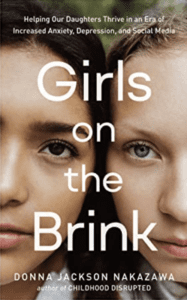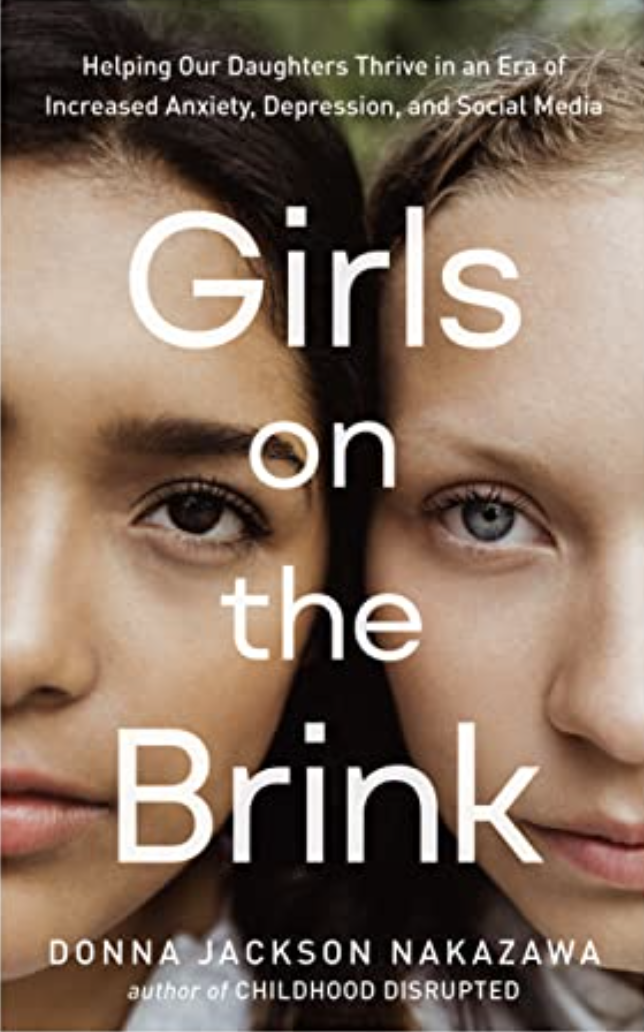Girls on the Brink brings together personal stories of young women, neuroscience and social science to bring an understanding of the biological, societal and personal forces acting on girls. Her thesis is this:
I don’t present this research to amplify fear, but rather as a clarion call to change the landscape in which girls come of age ~ pg. 85
You would be interested in this book if you:
(1) Were exploring the conflagration of forces acting on youth
(2) Wanted concrete steps and ideas for how to counter the negative forces
(3) Are a parent and / or educator of girls
(4) Were seeking a deeper understanding of the rise of social emotional distress in girls in particular
(5) Were an educator concerned about wellbeing of all students
 The book is divided into 3 main sections that I will talk about below: Part 1 is about “Growing up Female”, exploring how girls are wired and brought up differently; Part 2 is explaining “The New Science of Why Our Girls Are Struggling”, where the author presents new research that paints a new and emerging picture about the inner lives of girls; and, Part 3 is about “The Antidotes”, a series of actions and steps one can take to change the landscape for girls ~ this is the authors clarion call. But the Antidotes really only make sense having read the first two parts. These action steps are based upon our new and emerging understanding of the differences between boys and girls, so the research is essential.
The book is divided into 3 main sections that I will talk about below: Part 1 is about “Growing up Female”, exploring how girls are wired and brought up differently; Part 2 is explaining “The New Science of Why Our Girls Are Struggling”, where the author presents new research that paints a new and emerging picture about the inner lives of girls; and, Part 3 is about “The Antidotes”, a series of actions and steps one can take to change the landscape for girls ~ this is the authors clarion call. But the Antidotes really only make sense having read the first two parts. These action steps are based upon our new and emerging understanding of the differences between boys and girls, so the research is essential.
NOTE: this book does not address gender fluidity in enough detail, whatsoever. The research is focused on the biology of boys and girls.
Part 1 “Growing Up Female”
Statistics and research characterize this section, highlighting the inner lives of girls. She describes the complex and much different landscape than that of boys as a toxic soup :
“Our girls are simply not okay. Depression is occurring mor often in girls today than in the past, and it’s presenting earlier than it did just two decades ago…Every year, the gap between the rates at which girls and boys suffer from depression and anxiety persists – and between 2018 and 2019, that gap widened by 14 percent.” ~ pg. 8
Citing research that spans from new biological understandings of female children in the womb, impacts of Covid-19, social media, and a hyper-sexualized culture, she writes:
Science tells us that chronic stressors affect the female brain very differently from the male brain and that although these changes begin early on in development, they most often start to manifest during puberty in often harmful ways. ~pg 12
Research highlights 2012 as a tipping point where girls in the population became overly impacted by depression and anxiety, and this is directly correlated to when Facebook and Twitter added “Like” and “Retweet” buttons. This, along with a hyper-sexualized portrayal of women in all media, is “stealing away childhood, and robbing girls of the ever important time of play and social experimentation. (pg. 39)
She also cites the “Starling Effect” where society has shifted in two very important ways: (1) Social Media is up-close, personal, endemic, and all pervasive – and it is competitive through measurement ~ number of likes, and comments; and (2) because of this competition, girls are pitted against one another in all things (pg. 41)
…School days are longer and more regimented, and every family is its own island, each of whose inhabitants hope their offspring will get the best and be the best at everything. This kind of familial isolationism is changing the society in which we live and adding to the stress burden on teens during a critical developmental window – at exactly the time when they need added reassurance that the community and that the community at-large has their back… ~ 42
We are leaving our girls to fend for themselves. We, as adults, haven’t navigated this landscape before because we grew up differently. We can’t model, can’t understand and relate to their experiences.
Part 2: The New Science of Why our Girls Are Struggling
The changing landscape, the toxic soup, has changed fundamentally, and the biological underpinnings of girls feels this especially. Girls are wired differently from an evolutionary perspective. This strength, this super-power of a “spidey-sense” of imminent harm, either socially or physically protected families since time immemorial. However, within this toxic soup, the “spidey-sense” of girls is going off all the time, what the author calls a “symbolic threat response”. This is severely impacting girls lymphatic system and causing inflammatory responses at an alarming rate – leading to a higher susceptibility to depression and anxiety.
Without adults and a community to help moderate and role-model how to deal with these new stressors (social media, fear of exclusion, constant measurement and judging, etc…) our girls are not okay.
The early onset of puberty is exacerbating this derailing of thriving. Through media there is an emphasis on body image, sex signalling and diet that contribute to early onset of puberty. Puberty then remodels the brain at a time when the brain is not ready, and thus the brain is ‘opening up at the wrong time.’ ~pg. 89
“We [as a society] have created a social-environmental landscape that may be altering the female stress-immune response in ways that turn on genes that derail thriving” ~ 73
Part Three: The Antidotes
This is by far the most powerful and inspiring chapter for educators. The author has outlined 15 Antidotes. These are action-oriented, research-based, and philosophically aligned that can “…judiciously, lovingly [and] appropriately intervene, to the best of our ability, to keep trauma and adversity from switching on genes for future mental and physical health struggles.” (pg. 115). In short, these are strategies for educators and parents to practice that act as neuro-protection for girls living in this toxic soup.
I won’t list them all here, they are each one important and have applications to all children, not just girls. But a few do stand out:
(1) “Encourage a Sense of Mastery” – this is about building a sense of competence over time, “A mastery curve experience is one of the most powerful support systems an adolescent can have beneath them.” (pg. 205) The struggle, growth, and supports for that growth, enliven hope, optimism and life satisfaction, and develops a sense of self-efficacy. (pg. 205) This also provides them the tools for agency.
(2) “Help her Develop of Resistance” – this includes role modelling and practicing language to recognize and safely deter and safely squash unwelcome advances, physical and emotional. It is also about unlearning traditional gender roles. (pg. 210) And on pg. 214 there are two pages of examples of powerful language.
(3) “Have her write down to Break the Cycle of Negative Self-Talk” – This supports a rewiring of the neurological pathways that get strengthed by social media comments, exclusion and the like. The use of narrative writing is a skill that we can practice and model and ask of our girls, to help interupt the cycle of negative self-talk, and gaslighting.
This book provides the research, science, journalism, and rationale for its thesis. And it is powerful. It is asking us to reexamine the recent movements to ‘lean-in’, and to develop ‘grit and resilience’, without closely examining the health ramifications for doing so; not to mention how these enable the toxic soup to exist and persist.
This book also provides a sense of hope and optimism through the Antidotes that will impact your practice as a parent and educator. The saying goes that fish don’t notice the water, but this book argues that we have to see the soup that we are creating and ultimately living in.
I highly recommend this book for educators, of all children, if only to see the soup and to do something about it.
